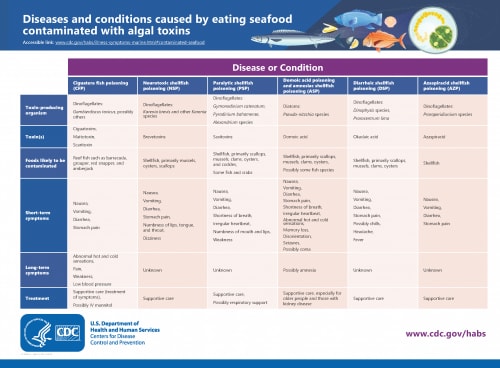Illness and Symptoms: Marine (Saltwater) Algal Blooms

Algae that can produce toxins can make both people and animals sick. Learn more about illnesses and symptoms caused by harmful algal blooms (often called red tides) in salt water.
People can get sick from algal blooms in marine (salt) waters
Common marine harmful algal bloom toxins include:
- Brevetoxin
- Azaspiracid
- Ciguatoxin
- Domoic acid
- Okadaic acid
- Saxitoxin
- Dinophysistoxin
Did you know? Red tides in the Gulf of Mexico are caused by the dinoflagellate Karenia brevis, which can produce toxins called brevetoxins. These toxins can build up in seafood and be found in sea spray.
In salt water, such as oceans and bays, harmful algal blooms are most commonly caused by diatoms and dinoflagellates, which are two kinds of phytoplankton (single-celled organisms).
Some diatoms and dinoflagellates can produce toxins (poisons). When people or animals are exposed to these toxins, they can become sick.
Symptoms depend on:
- How a person or animal was exposed
- How long they were exposed
- Which type of toxin they were exposed to
People and animals are exposed to marine algal toxins through:
- Eating shellfish or fish containing toxins
- Swimming or other activities in the water
- Breathing in tiny droplets in the air that contain toxins
People can get sick and have symptoms.
Symptoms vary depending on the type of toxin the person was exposed to.
One of the most common types of harmful algal blooms in the United States is Karenia brevis blooms (also called Karenia brevis red tides) in the Gulf of Mexico. An algal toxin that is often produced during these blooms is called brevetoxin.
Breathing in sea spray or getting water containing brevetoxin on your skin can cause symptoms including:
- Respiratory irritation (coughing, sneezing)
- Shortness of breath
- Throat irritation
- Eye irritation
- Skin irritation
- Asthma attacks
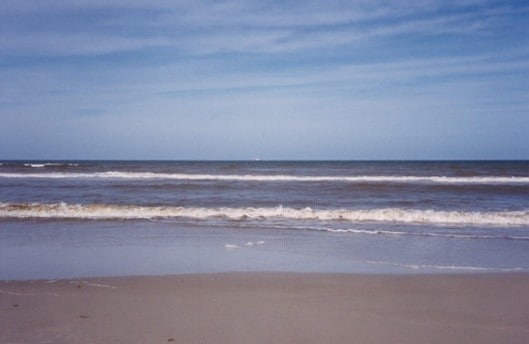
Karenia brevis red tide, Florida, March 2002. Photo by Lorraine Backer
Types of illness that can be caused by eating seafood contaminated with toxins from harmful algae:
- Ciguatera Fish Poisoning (CFP)
- Neurotoxic Shellfish Poisoning (NSP)
- Paralytic Shellfish Poisoning (PSP)
- Domoic Acid Poisoning and Amnesiac Shellfish Poisoning (ASP)
- Diarrheic Shellfish Poisoning (DSP)
- Azaspiracid Shellfish Poisoning (AZP)
For more information on signs and symptoms of illnesses caused by marine toxins, see the Diseases and conditions caused by eating seafood contaminated with algal toxins section below or visit CDC’s Yellow Book, Chapter 2: Food Poisoning from Marine Toxins.
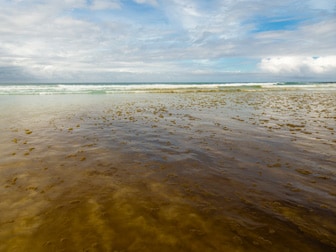
Learn how to protect yourself and your loved ones from harmful algal blooms.
If you think you may have symptoms caused by a harmful algal bloom in salt water, you can:
- Talk to your healthcare provider for advice about how to relieve your symptoms. Let them know that you might have recently come in contact with a bloom or its toxins. While there are currently no available tests or special treatments for illnesses caused by algal toxins, information about the suspected cause of your illness might help your healthcare provider manage your symptoms.
- Call your poison control center hotline at 1-800-222-1222. The specialists might be able to provide information about illnesses caused by blooms.
- Report any illnesses that you believe were caused by algal toxins to your local or state health department. This can help them understand and prevent harmful algal blooms and illnesses. Some state health departments have forms on their websites or hotlines for reporting suspected bloom-associated illnesses directly to the health department.
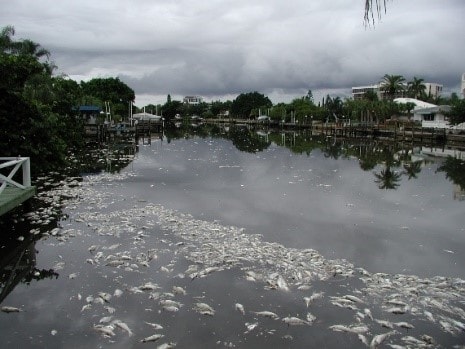
Fish kill in inland canal, Sarasota, Florida. Photo by Lorraine Backer
Animals can be poisoned by swimming in water with a marine harmful algal bloom or by eating fish or shellfish containing marine toxins. These toxins can build up in seafood through larger fish eating smaller fish. When animals are exposed, they can develop neurological damage or die within hours to days of swimming in unsafe water or eating seafood that contains toxins.
In marine mammals, fish, and other aquatic marine life, exposure to algal toxins can cause widespread illness or death. Animals can be poisoned in different ways and have different symptoms.
Fish
Fish kills (large die-offs of fish) can be caused by toxins called brevetoxins from blooms of the dinoflagellate (single-celled organism) Karenia brevis.
Mammals
Indian manatees can be poisoned by brevetoxins from blooms of the dinoflagellate Karenia brevis and may have fatal respiratory damage.
Dolphins can also be poisoned by this toxin, resulting in many animals stranded on beaches.
California sea lions can be poisoned by a toxin called domoic acid from blooms of the diatom (single-celled organism) Pseudo-nitzchia and experience neurologic effects, including seizures and unusual behavior.
Birds
Birds can get sick and die after eating algae or contaminated marine fish or shellfish. For example, pelicans and cormorants have been poisoned by these toxins. In some cases, thousands of birds died.
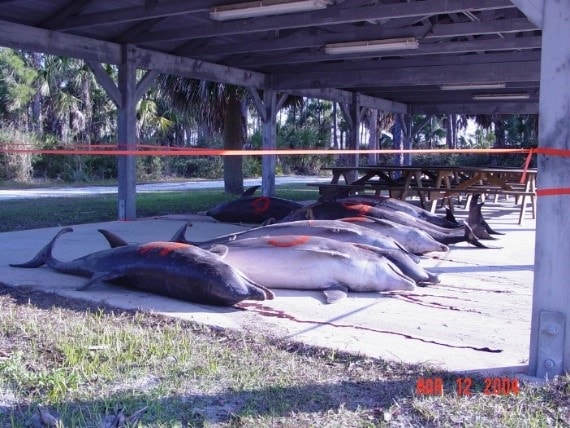
Dolphins from a mass stranding from poisoning by eating contaminated menhaden. Photo courtesy of Florida Fish and Wildlife Conservation Commission.
The long-term health effects of harmful algal blooms in people and animals remain unclear. Because we are still learning about the long-term health effects, it’s important to take steps to keep yourself and your pets safe, such as not going into water containing harmful algal blooms. Learn more about how to prevent exposure to harmful algal blooms.
Talk with your healthcare provider if you have questions about your health and exposure to a harmful algal bloom.
Download a table [PDF – 3 MB] showing the diseases and conditions caused by eating seafood contaminated with algal toxins.
- Foods likely to be contaminated: Reef fish such as barracuda, grouper, red snapper, and amberjack
- Short-term symptoms: Nausea, vomiting, diarrhea, stomach pain
- Long-term symptoms: Abnormal hot and cold sensations, pain, weakness, low blood pressure
- Treatment: Treatment of symptoms (supportive care), possibly IV mannitol
- Toxin-producing organism:Dinoflagellates: Gambierdiscus toxicus, possibly others
- Toxins: Ciguatoxins, Maitotoxin, Scaritoxin
- Foods likely to be contaminated: Shellfish, primarily mussels, oysters, scallops
- Short-term symptoms: Nausea; vomiting; diarrhea; stomach pain; numbness of lips, tongue, and throat; dizziness
- Long-term symptoms: Unknown
- Treatment: Treatment of symptoms (supportive care)
- Toxin-producing organism:Dinoflagellates: Karenia brevis and other Karenia species
- Toxins: Brevetoxins
- Foods likely to be contaminated: Shellfish, primarily scallops, mussels, clams, oysters, and cockles; some fish and crabs
- Short-term symptoms: Nausea, vomiting, diarrhea, shortness of breath, irregular heartbeat, numbness of mouth and lips, weakness
- Long-term symptoms: Unknown
- Treatment: Treatment of symptoms (supportive care), possibly respiratory support
- Toxin-producing organism:Dinoflagellates: Gymonodinium catenatum, Pyrodinium bahamense, Alexandrium species
- Toxins: Saxitoxins
- Foods likely to be contaminated: Shellfish, primarily scallops, mussels, clams, and oysters; possibly some fish species
- Short-term symptoms: Nausea, vomiting, diarrhea, stomach pain, shortness of breath, irregular heartbeat, abnormal hot and cold sensations, memory loss, disorientation, seizures, possibly coma
- Long-term symptoms: Possibly amnesia
- Treatment: Treatment of symptoms (supportive care), especially for older people and those with kidney disease
- Toxin-producing organism:Diatoms: Pseudo-nitzchia species
- Toxins: Domoic acid
- Foods likely to be contaminated: Shellfish, primarily scallops, mussels, clams, and oysters
- Short-term symptoms: Nausea, vomiting, diarrhea, stomach pain, possibly chills, headache, fever
- Long-term symptoms: Unknown
- Treatment: Treatment of symptoms (supportive care)
- Toxin-producing organism:Dinoflagellates: Dinophysis species, Prorocentrum lima
- Toxins: Okadaic acid
- Foods likely to be contaminated: Shellfish
- Short-term symptoms: Nausea, vomiting, diarrhea, stomach pain
- Long-term symptoms: Unknown
- Treatment: Treatment of symptoms (supportive care)
- Toxin-producing organism:Dinoflagellates: Proroperidiunium species
- Toxins: Azaspiracid
